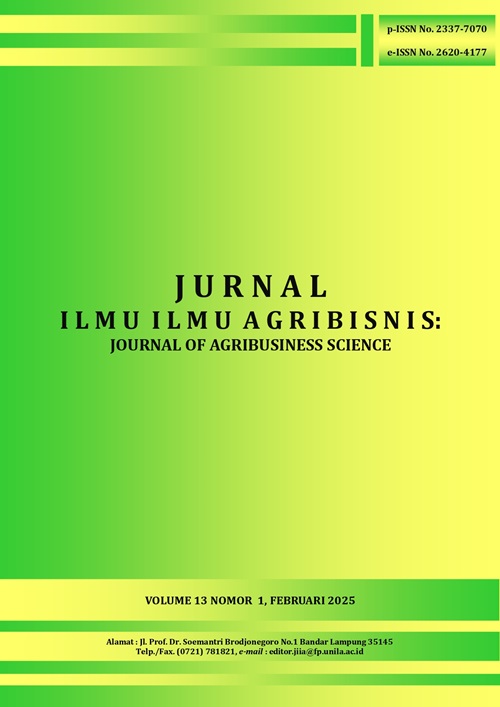KETAHANAN PANGAN RUMAH TANGGA PETANI KARET DI KECAMATAN TULANG BAWANG UDIK KABUPATEN TULANG BAWANG BARAT
DOI:
https://doi.org/10.23960/jiia.v13i1.8983 Abstract View: 145
Abstract View: 145
Abstract
Rubber is a widely cultivated plantation commodity, but the volatility of rubber prices poses a problem for farmers, as it affects the ability to meet food demands in terms of both quantity and quality. The motivation behind this study was to analyze the level of food security and the quality of household food consumption of rubber farmers in Tulang Bawang Udik Sub district, West Tulang Bawang Regency. This study used survey method with a sample of forty-eight rubber farming households from two villages with land areas of less than one hectare, selected by simple random sampling. Food security was measured by cross-classification between the proportion of food expenditure and the level of household energy consumption. Calculation of household food expenditure was based on a monthly period, while the energy consumption level used the actual energy consumption indicator together with the energy consumption indicators obtained by the recall method. The quality of food consumption patterns was analyzed by determining the PPH score. Computation of the PPH score was acquired by contrasting the genuine AKE score with the standardizing PPH (100). The outcomes show that the results of the cross-classification of energy sufficiency and the proportion of food expenditure are acquired from the four categories of rubber farmers, and the sustainability of household food security is 27,08%, less is 43,75%, while the proportion of vulnerable is 12,50% and food insecurity is 6,67%. With a PPH score of 62,49, diversity is not achieved in nine food groups of rubber farmer households.
Key words: food security, rubber farmer, food pattern of hope (PPH)
Downloads
Downloads
Published
How to Cite
Issue
Section
License
Authors who publish with this journal agree to the following terms:
Authors retain copyright and grant the journal right of first publication with the work simultaneously licensed under a Creative Commons Attribution License that allows others to share the work with an acknowledgement of the work's authorship and initial publication in this journal.
Authors are able to enter into separate, additional contractual arrangements for the non-exclusive distribution of the journal's published version of the work (e.g., post it to an institutional repository or publish it in a book), with an acknowledgement of its initial publication in this journal.
Authors are permitted and encouraged to post their work online (e.g., in institutional repositories or on their website) prior to and during the submission process, as it can lead to productive exchanges, as well as earlier and greater citation of published work (See The Effect of Open Access).














